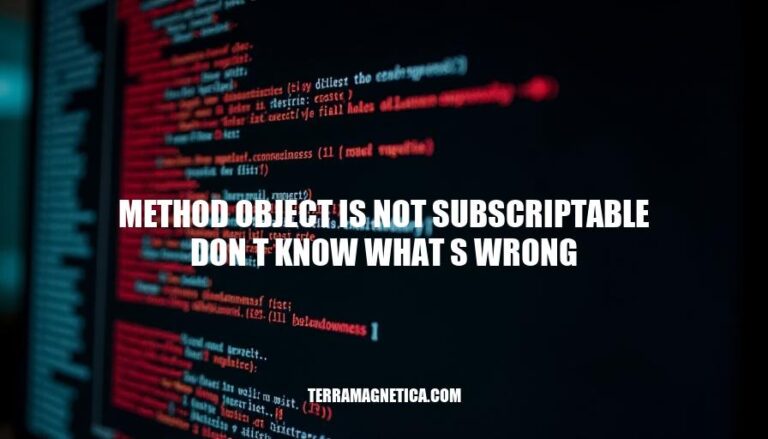


The “method object is not subscriptable” error in Python occurs when you mistakenly try to use square brackets to call a method, which is not allowed. This error typically happens because methods are not subscriptable objects, meaning they cannot be accessed like lists or dictionaries using square brackets. Common scenarios where this error might be encountered include attempting to access a method as if it were a list or dictionary, or forgetting to use parentheses when calling a method.
In Python, subscriptable objects are those that support indexing or slicing using square brackets ([]). This is facilitated through the __getitem__() method.
my_list = [1, 2, 3]
print(my_list[0]) # Output: 1
my_tuple = (1, 2, 3)
print(my_tuple[0]) # Output: 1
my_dict = {'a': 1, 'b': 2}
print(my_dict['a']) # Output: 1
__getitem__() method. Attempting to subscript a method results in a TypeError.def my_function():
return 42
print(my_function[0]) # TypeError: 'function' object is not subscriptable
Here are some common coding mistakes that lead to the 'method' object is not subscriptable error, along with examples of incorrect code snippets:
Using Square Brackets Instead of Parentheses to Call a Method:
class Human:
def talk(self, message):
print(message)
person = Human()
person.talk["Hello!"] # Incorrect
Assigning a Method to a Variable and Then Trying to Subscript It:
class Calculator:
def add(self, a, b):
return a + b
calc = Calculator()
add_method = calc.add
result = add_method[2, 3] # Incorrect
Forgetting Parentheses When Chaining Method Calls:
class TextProcessor:
def get_text(self):
return "Hello, World!"
def to_upper(self, text):
return text.upper()
processor = TextProcessor()
upper_text = processor.get_text.to_upper() # Incorrect
Confusing Method Calls with List Indexing:
class Data:
def get_list(self):
return [1, 2, 3]
data = Data()
value = data.get_list[0] # Incorrect
To fix these errors, always use parentheses () to call methods and avoid using square brackets [] unless you are working with subscriptable objects like lists, tuples, or dictionaries.
Here are the step-by-step instructions to resolve the ‘method object is not subscriptable’ error:
Identify the Error Source:
[] to call a method instead of round brackets ().Correct the Method Call:
class Human:
def talk(self, message):
print(message)
person = Human()
person.talk["How are you?"] # ❌ Incorrect
person.talk("How are you?") # ✅ Correct
Explanation: Methods should be called with round brackets (), not square brackets [].
class Human:
def greet_friends(self, friends_list):
for name in friends_list:
print(f"Hi, {name}!")
person = Human()
person.greet_friends['Lisa', 'John', 'Amy'] # ❌ Incorrect
person.greet_friends(['Lisa', 'John', 'Amy']) # ✅ Correct
Explanation: Even when passing a list to a method, you need to use round brackets ().
max[2] # ❌ Incorrect
max([1, 2, 3]) # ✅ Correct
Explanation: Built-in functions like max should also be called with round brackets ().
By following these steps and using the correct syntax, you can avoid the ‘method object is not subscriptable’ error.
Here are some best practices and tips to avoid the ‘method object is not subscriptable’ error:
() to call methods. For example, use object.method() instead of object.method[].type() or isinstance() to verify.Understanding the properties and behaviors of different object types is crucial to avoid such errors and write robust code. Happy coding!
To avoid the ‘method object is not subscriptable’ error, it’s essential to understand which objects are subscriptable (e.g., lists, tuples, dictionaries) and which are not (e.g., methods, functions).
Always use parentheses () to call methods, such as object.method() instead of object.method[].
Before subscripting, ensure the object is of a type that supports it by checking its data type using type() or isinstance().
Avoid naming variables the same as methods or functions to prevent confusion.
Regularly review your code and keep it well-documented to clarify the intended use of objects and methods.
By following these best practices and tips, you can write robust code and avoid common errors like ‘method object is not subscriptable’.